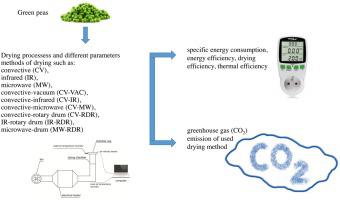Chemical Engineering and Processing: Process Intensification ( IF 3.8 ) Pub Date : 2020-12-17 , DOI: 10.1016/j.cep.2020.108274 Mohammad Kaveh , Yousef Abbaspour-Gilandeh , Malgorzata Nowacka

|
The aim of the study was to analyze the drying process of green pea using different dryers and different parameters of drying, and evaluate the specific energy consumption, energy efficiency, drying efficiency, thermal efficiency, and greenhouse gas (CO2) emission of used drying method. The drying methods included convective, infrared, microwave, convective-vacuum, convective-infrared, convective-microwave, convective-rotary dryer, infrared-rotary dryer, and microwave-dryer. Results indicated the lowest specific energy consumption for the microwave dryer working at the power of 810 W (12.15 MJ/kg); whereas the highest specific energy consumption (215.45 MJ/kg) was observed in the convective drying (40 °C, 1.5 m/s). The highest energy efficiency, drying efficiency, and thermal efficiency (57.98 %, 65.11 %, and 57.98 %, respectively) were obtained by the microwave working at the power of 810 W. The energy, thermal, and drying efficiencies showed an increasing trend with elevating the temperature, microwave power, and infrared power. Furthermore, the analysis showed that by increasing the air temperature, microwave, infrared powers, and rotation speed, and reducing the inlet air velocity, the CO2 generation was decreased. The lowest CO2 amount (5.5 kg/kg water) was produced during the microwave drying at the power of 810 W.
中文翻译:

豌豆不同干燥技术及其碳排放的比较
该研究的目的是使用不同的干燥机和不同的干燥参数来分析青豆的干燥过程,并评估比能耗,能量效率,干燥效率,热效率和温室气体(CO 2)。)排放用过的干燥方法。干燥方法包括对流,红外,微波,对流真空,对流红外,对流微波,对流旋转干燥机,红外旋转干燥机和微波干燥机。结果表明,在功率为810 W(12.15 MJ / kg)的情况下,微波干燥机的最低单位能耗;而在对流干燥(40°C,1.5 m / s)中观察到最高的单位能耗(215.45 MJ / kg)。通过微波在810 W的功率下工作,可获得最高的能量效率,干燥效率和热效率(分别为57.98%,65.11%和57.98%)。能量,热效率和干燥效率均呈上升趋势。升高温度,微波功率和红外功率。此外,2代减少。在微波干燥过程中以810 W的功率产生的最低CO 2量(5.5 kg / kg水)。











































 京公网安备 11010802027423号
京公网安备 11010802027423号